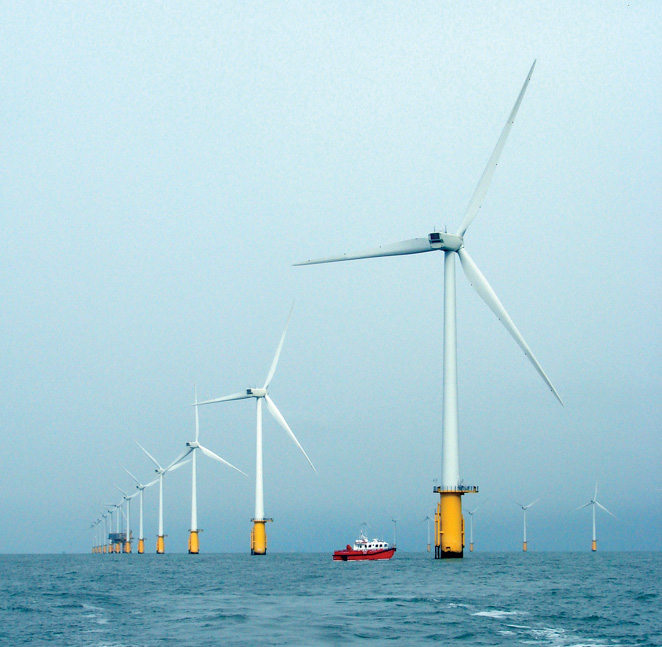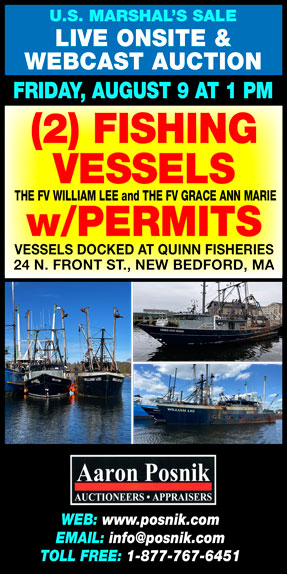 As the siting of ocean wind energy projects continues along the East Coast, many fishermen are left wondering how wind energy development will affect fishing resources.
As the siting of ocean wind energy projects continues along the East Coast, many fishermen are left wondering how wind energy development will affect fishing resources.
What is involved in testing an area for a wind farm and installing the turbine array? How will the underwater drilling, jet plowing, cable laying, and turbine installation affect fish, lobsters, and shellfish in an area? How will the resource respond once installation is complete? What will be the overall harm and benefit of a wind farm – or many of them – to target species?

Turbines that are part of the Thanet Offshore Wind Farm off the coast of England. Given that ocean wind energy is a new industry, the long-term effects of wind farms on the benthic and marine environment are not known.
(John Williamson photo)
Scientists and fishermen know the answers to some of these questions already. Yet some effects of wind farms are poorly understood. On a recent trip to England, fishermen there provided anecdotal evidence of what they have seen to date (see CFN May 2013 for trip background). Their experiences provide US fishermen insight on what they can expect should a wind farm be sited where they fish.
Developers interested in constructing an ocean-based wind farm have to characterize the site before installation can begin. Site characterization involves conducting many surveys and tests.
Drilling into the seafloor and removing cores of sediment help developers determine the type of bottom and depth of material in a given area. Surveys of the area are conducted by towing instruments from vessels across the proposed area and by using remotely operated vehicles to roam the ocean floor and take pictures. Weather buoys and other meteorological towers also are installed.
Once a site is characterized and chosen for construction, installation will begin. Cables will be laid on top of or buried under the seafloor. Burial often requires jet plowing horizontally below the seafloor. If necessary, rocks or other heavy structures may be piled on top of the cables, known as “mattressing,” to ensure they don’t move.
Wind turbines either will be drilled into the seafloor at great depths or they will sit on top of the seafloor. To reduce scour, the piles will be jacketed or have rocks piled at their base. The spinning blade will be affixed to the turbine after the base is installed.
During site characterization and construction, fishermen can expect an increase in underwater noise, vibration, and disturbance of the ocean floor. They also can expect an increase in vessel traffic and possible closure of certain areas. Testing can occur over the course of years or in spurts of condensed activity. We expect mariners notices will be issued alerting fishermen to any activity that would affect their safety or operations.
Marine life response
What species a fisherman targets matters a great deal in determining the extent to which a wind farm may affect his operations. The take-home message we heard from fishermen in England is that the more mobile the species, the less vulnerable it is to testing, installation, and operation of a wind farm, and the less mobile the species or resource is, the more vulnerable it is.
Some effects are temporary, while others are long lasting. Some are localized to a single turbine, while others reach far outside the wind array’s borders.
If you target mobile fish, any activity that creates underwater noise or vibrations will have the greatest impact. Fishermen can guess that mobile finfish will scatter during the most intrusive testing or installation activities, such as drilling or jet plowing. Testing and installation activities have similar impacts on mobile crustaceans like lobsters. They, too, will scatter during disruptive activities.
Once the wind farm is installed, however, some kinds of finfish are attracted to the structure. This phenomenon is not surprising because it is well known that fish often are attracted to fixed underwater structures.
Fishermen in England noted that “cod, plaice, groundfish,” and certain pelagic species tended to hide out among the turbines.
They also observed an abundance of skates in the arrays. One fisherman theorized that skates congregated in the array because the cables give off heat. Yet he also observed a reluctance by skates to cross the cables, possibly due to the electromagnetic field created by current running through the cable.
Crustaceans like lobsters and crabs, along with certain mollusks, also are attracted to the base of the turbines, especially if rock piles are used as scour protection. Mussels especially like to attach to the base and thrive in wind farms, a fact noted by fishermen and scientists alike.
Unwelcome predators
Although the artificial reef effect of a wind farm may be strong, not all species are welcome. Known predators, such as starfish, also are attracted to the arrays. Starfish prey on oysters and scallops.
For any seafloor dwelling species, such as scallops and oysters, the introduction of starfish to an area can devastate the resource. The financial hit to currently lucrative scallop and oyster beds can be extraordinary.
Another issue for mollusks and crustaceans arises if the wind farm is built in an area with sandy or muddy bottom. If the area experiences strong ocean currents or tides, sedimentation can suffocate species.
One lobsterman in England explained that years after installation, the turbines cause major scour in sandy and muddy bottoms, which causes the water to be heavy with sediment. The sediment gets in the crevices of rock structures, suffocating the lobsters that are there.
Sedimentation can be so bad that it affects fish even outside the array. We heard reports that lobsters caught in traps set in areas near arrays off of England’s south coast often are dead by the time the traps are hauled.
Oyster and scallop beds are particularly vulnerable. Drilling, jet plowing, or pile driving in these areas will crush portions of the resource. Although some species can respond to perceived danger by moving away from it, federal agencies have acknowledged that localized crushing may occur.
Furthermore, oyster and scallop beds themselves are not able to move. Stirred up sediment caused by testing and installation activities and ongoing sedimentation can blanket the beds, killing the resource. We heard reports in England that dredging in once-productive areas in and near wind farms brought up only dead fish and shellfish.
Scientists and fishermen do not know the long-term effects of wind farms on the benthic and marine environment. They don’t know how large swaths of the ocean covered in structures will affect spat settlement patterns, migratory patterns, feeding habits, or predation.
Federal agencies currently are working with limited scientific information and are basing decisions on the belief that any effects caused by wind turbines are either temporary or minimal.
For fishermen, however, these unknowns are a reminder that the ocean wind energy industry is fairly new. Any attempt to base decisions on the limited data may have unforeseen – and possibly negative – consequences.
Michele Hallowell
Michele Hallowell is an associate in the Washington, DC office of Kelley, Drye and Warren, LLP and former in-house counsel to the Maine Lobstermen’s Association. She was a member of a fact-finding team that traveled to England in March to learn how fishermen there are dealing with extensive offshore wind farm construction.
Back to the June 2013 Issue of CFN








